The motorcycle business has evolved a full circle at Honda. It brought the world high-tech bikes, higher-tech bikes, superbikes and then pushed the envelope to supersports, this giant punching through every barrier of motorcycle development along the way.
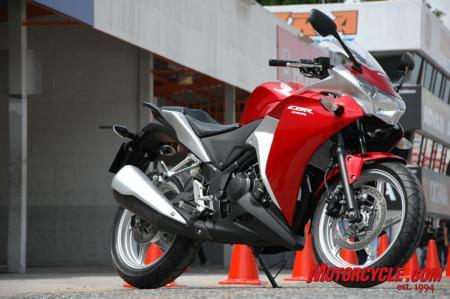 2011 Honda CBR250R 2011 Honda CBR250R |
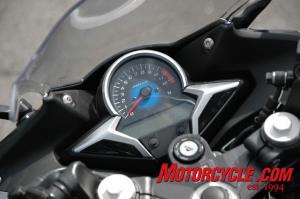
The attractively faired CBR250R looks a full-size bike. This sporty quarter-liter motorcycle resembles Honda’s VFR1200F, also sporting a mass-centralized stance. The front fairing extends down to shroud its engine bay, and a curved visor provides ample high speed wind protection, wrapping around a sporty cockpit.
Neat attention to detail is apparent in the attractive steering head region, and you get clip-ons mounted above the triple clamp. We liked the 250R’s blue backlit LCD instruments with silver trim and a compact, easily deciphered layout. An analog tachometer dominates this bay, while you also see a bold digital speedometer, in addition to odometer, trip-counter, clock, fuel and temperature readouts. Switches include all you require, while there are smart buffed-alloy levers and nice feeling palm grips, although we missed the functionality of an adjustable clutch lever.
The tank looks and feels nice thanks to perfectly sculpted knee grooves. Futuristic flank panels swoop back into a bi-color tail, split grab bars and angular brake warning light. There’s also a sharp belly pan, stubby silencer crafted from blackened stainless steel and well-defined footrests. A utility box tucks under the CBR250R’s split seats.
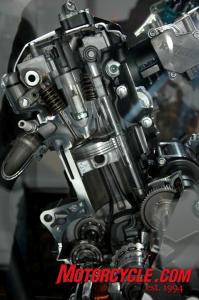 Here's a cutaway of Honda's new 249cc, single-cylinder engine.
Here's a cutaway of Honda's new 249cc, single-cylinder engine.Honda has developed a new 249cc, 4-stroke, dual-overhead-camshaft engine for the CBR250R. The liquid-cooled, single-cylinder powerplant is fuel-injected via a twin-beam, Honda PGM-FI system.
The centrifugal cast, thin-wall cylinder sits 4mm offset from the crankshaft center towards the exhaust side to reduce friction between the cylinder and molybdenum-coated piston. There’s a textured sleeve exterior for better heat dispersion, while the combustion chamber uses pentroof architecture. An iridium spark-plug is deployed in the new engine that uses four lightweight valves propped up on slender stems. The CBR250R enjoys the world’s first roller rocker arms on any DOHC engine, with tappet clearance relying on shim adjustment.
Peak power at the crankshaft is stated to be 25.8 hp at 8500 rpm, while a maximum torque figure of close to 16.6 ft-lb at 7000 rpm is to be expected, varying from market to market.
That reads all very well on paper, but feels more fun commanded by your own enthusiastic wrist. The engine note is pleasantly gruff yet soft. Engine revs build with a willing thrum the instant you select first, open throttle and let out the well-weighted clutch. Throttle response is crisp, the CBR250R enjoying a wide, thoroughly refined powerband even novices wont hesitate to exploit. Revs rise in a smooth, purposeful rush through an adequate low end, meeting a meaty midrange and frantic top-end rush as expected from the short-stroke powerplant.
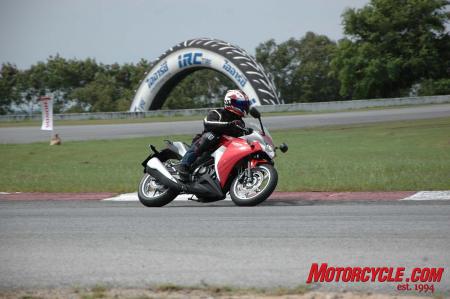 Our Indian correspondent had a chance to test out the new CBR250R on the track. Our Indian correspondent had a chance to test out the new CBR250R on the track. |
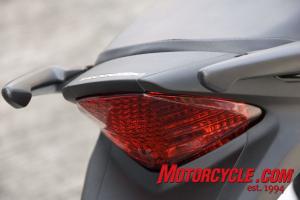
A diamond frame with steel pipe trusses holds the CBR250R together, with 37mm telescopic front suspension, a rectangle-section swingarm and 5-step adjustable Pro-link system at the rear. Wheels are 17 inches, with ample tires, a 140/70 section used at rear.
The CBR250R riding position is midway between commuter-upright and sporty, and kept my wrists stress free during this short ride. The saddle offers good padding, making this a comfortable steed. Ride quality feels plush, although this was difficult to judge on the racing circuit.
Handling is light, street-friendly and stable through the corners. The Honda doesn’t handle with the sharp edge of a more radical race replica bike. It feels softer and forgiving, sure-footed enough for the occasional track day, still essentially a comfortable motorcycle well suited to daily use.
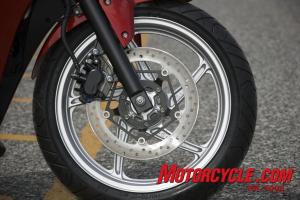 U.S. customers can choose Honda’s innovative C-ABS for an extra $500.
U.S. customers can choose Honda’s innovative C-ABS for an extra $500.Honda is offering top drawer Combined ABS front (296mm floating disc) and rear (220mm) disc brakes as an option. The combined system is calibrated to intervene and distribute brake pressure to the front and rear whenever you depress the rear brake, while the front brake lever works independently as on any motorcycle. Both ends are ABS enabled, the system modulating hydraulic pressure and preventing wheel lock in every situation.
The uphill back straight at Bira ends in a tricky chicane lurking behind a crest, and this made it a nasty habit of leaping out of nowhere into my sight at close to 80 mph with frightening regularity. That’s exactly when I felt the CBR chassis and my track abilities shimmying close to the edge, only to be rescued lap after lap thanks to the amazing brakes.
My contribution was no more than to jump on the brakes and hang on, from where the C-ABS system took over and worked its magic without any drama. I never needed to alter my braking habits, or felt the Combined ABS system intruding on riding pleasure or brake feel. It’s a clever system that will make a pro of most novices.
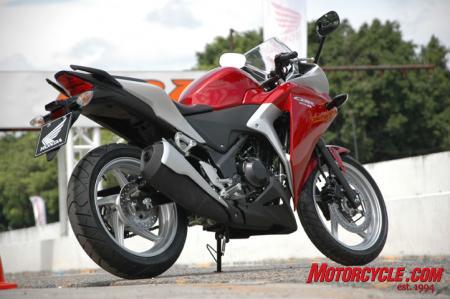 |

0 Comments:
Post a Comment